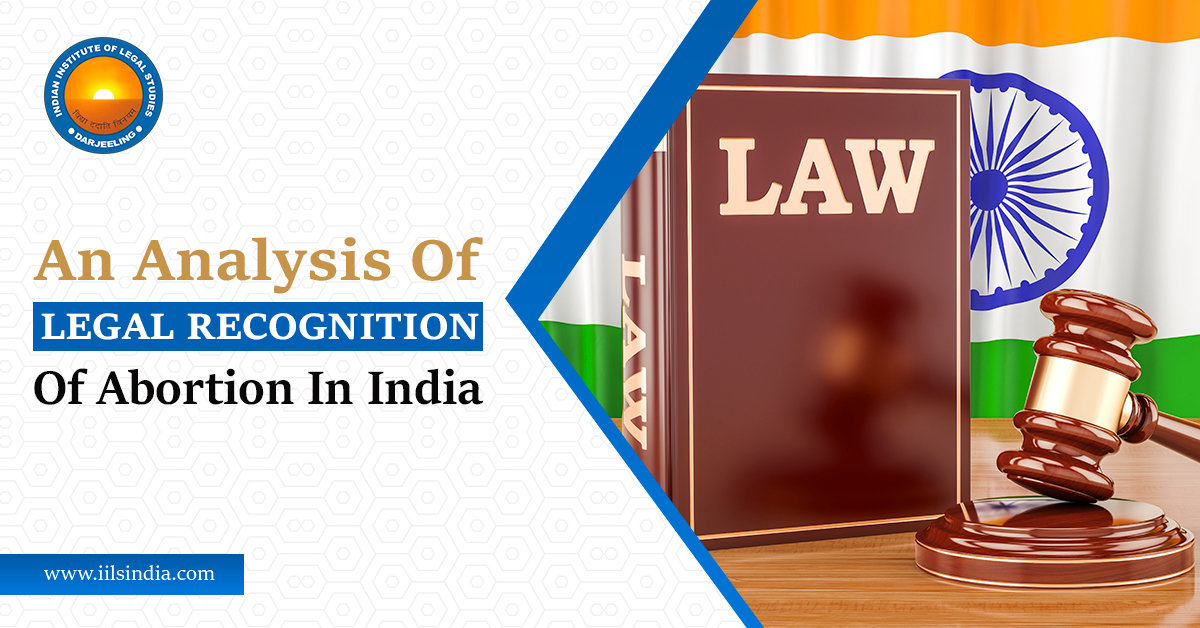Abstract
For centuries, the concern for legal recognition of abortion has been in the forefront of debates and discussions among different nations as well as international organizations. Abortion has always remained a matter of conflict between ethics and law.
Introduction
The right of abortion has acquired an important position in society due to its legal recognition in the statutory law and principles. In India, among several attempted changes, one has already been enacted into law: the Termination of Pregnancy Act, 1971, which liberalized the previously limited legislation of abortion to include even those who conceive as a consequence of the failure of contraceptives. Abortion is one such realm where the two most important rights stand at conflicting interest- the rights of pregnant women and the right of the child in the womb. It is significant to ensure that neither of rights gets suffered against the interest of another right. Therefore, a proper balance has always been the need of the hour that would promote the interest of both the mother and the child in the womb. In addition to the rights of pregnant women and the rights of the child in the womb, the concept of abortion has also put the position of a father in question which also required a prominent attention. Every individual in the society must enjoy the benefits of human rights and humanity. Hence, such issues that attracts the attention of the entire world needs to be discussed in best colleges for law and other related field to understand the legalities of the same.
Meaning And Concept of Abortion
It is significant to define the term abortion to have a better understanding of its concept. The term “abortion” is derived from the Latin word “aboriri” which means getting detached from the actual site or place.
Historical Background of Abortion
The history of abortion can be linked to the Indian Civilisation. Despite the fact that abortion is legal everywhere, practically all civilizations and social systems try to restrict and regulate it through moral codes, mores, religious taboos, and laws of the government. Forced abortion is found in numerous Indian texts, including the Rig Veda, Dharma Sutras, and Smritis, which all denounce it as a sin. Some connections to abortion may also be found in later epics such as the Mahabharata and Ramayana.
Relevance of Indian Penal Code
Before going into the details of Medical Termination of Pregnancy Act 1971, it is important to understand the provisions of Indian Penal Code which talks about abortion or miscarriage. The Indian Penal Code by virtue of several sections criminalized the action of miscarriage. Section 312 of IPC makes the miscarriage a punishable offense for those who cause it to a pregnant woman except if it is done to save the life of the pregnant woman. Similarly, Section 313 talks about the punishment for causing miscarriage without the consent of the pregnant woman. Furthermore, Section 314 deals with the cases of death of pregnant women during the performance of an act which is intended to cause miscarriage. Therefore, the above-mentioned provisions have significantly played a very important role in reducing the conduct of abortion in India.
Medical Termination of Pregnancy Act, 1971
The Medical Termination of Pregnancy Act, 1971 is widely regarded as one of India’s most significant pieces of social legislation. The credit for introducing the liberalised measures of abortion goes to the Shantilal Shah Committee in the year 1964. For minimising several issues with respect to population explosion and maternal mortality, the committee suggested the reforms to legalise the concept of abortion in India. This suggestion led to the passing of the Medical Terminal Act, 1971.
The Act provides two options for termination of pregnancy. Firstly, where the pregnancy has not exceeded twelve weeks, the concerned medical practitioners have to form an opinion with respect to the existence of one of the grounds specified in Section 3 of the Act. Section 3 talks about two grounds: First, it revolves around the involvement of risk to the life of a pregnant woman or injury related to physical or mental health. Second, it talks about the substantial risk with respect to the physical health of the child if it is born. Secondly, in the cases where the length of the pregnancy has not extended twenty weeks, two registered medical practitioners need to form the opinion on the ground of abortion. The question of termination of pregnancy has always posed a great challenge before the court of law.
However, the question of terminating pregnancy is not a challenge in rapes cases. In the case of Komalavalli v. C.R. Nair (1984 Cr LJ 446), the court held that continuation of unwanted pregnancy resulting from rape cases would result in traumatic and psychological shock. Therefore, the court allowed the termination of pregnancy by qualified doctors. Similar liberal decisions have been observed in the cases of Km. Mahima v. State (2003) and D. Rajeswari v. State of Tamil Nadu (1996). Therefore, it has been observed that the Medical Termination of Pregnancy Act of 1971 put forward several grounds for termination of pregnancy; and these grounds reflect the widespread belief in the permissibility of abortion in most areas of the world.
Conclusion It is important to note that the Act, 1971 does not provide the right of abortion on demand. Under the Act, the abortion is not a rule, but an exception which has been granted to the medical practitioners from escaping the umbrella of criminal charges. The Medical Termination Act, 1971 has been recently amended in the year 2021. One of the important amended provisions is that a married woman may terminate a pregnancy up to 20 weeks after the failure of a contraceptive technique or device under the Act. Therefore, every best college for law must incorporate the new amended Act i.e. Medical Termination of Pregnancy (Amendment) Act 2021 in the syllabus as it would keep the students up-to-date with the recent changes of such an important dynamic law.

